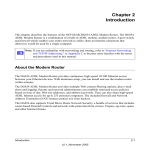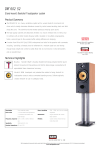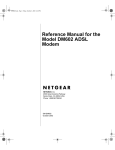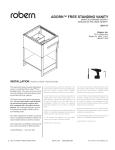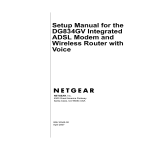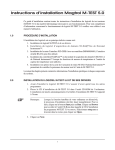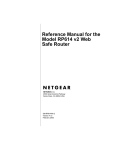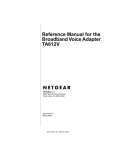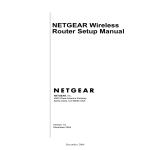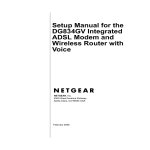Download Netgear DM602 User's Manual
Transcript
DM602.book Page i Monday, August 12, 2002 6:09 PM Reference Manual for the Model DM602 ADSL Modem NETGEAR, Inc. 4500 Great America Parkway Santa Clara, CA 95054 USA Phone 1-888-NETGEAR SM-DM602NA-0 August 2002 DM602.book Page ii Monday, August 12, 2002 6:09 PM © 2002 by NETGEAR, Inc. All rights reserved. Trademarks NETGEAR is a trademark of Netgear, Inc. Microsoft, Windows, and Windows NT are registered trademarks of Microsoft Corporation. Other brand and product names are registered trademarks or trademarks of their respective holders. Statement of Conditions In the interest of improving internal design, operational function, and/or reliability, NETGEAR reserves the right to make changes to the products described in this document without notice. NETGEAR does not assume any liability that may occur due to the use or application of the product(s) or circuit layout(s) described herein. Federal Communications Commission (FCC) Compliance Notice: Radio Frequency Notice This equipment has been tested and found to comply with the limits for a Class B digital device, pursuant to part 15 of the FCC Rules. These limits are designed to provide reasonable protection against harmful interference in a residential installation. This equipment generates, uses, and can radiate radio frequency energy and, if not installed and used in accordance with the instructions, may cause harmful interference to radio communications. However, there is no guarantee that interference will not occur in a particular installation. If this equipment does cause harmful interference to radio or television reception, which can be determined by turning the equipment off and on, the user is encouraged to try to correct the interference by one or more of the following measures: • Reorient or relocate the receiving antenna. • Increase the separation between the equipment and receiver. • Connect the equipment into an outlet on a circuit different from that to which the receiver is connected. • Consult the dealer or an experienced radio/TV technician for help. EN 55 022 Declaration of Conformance This is to certify that the Model DM602 ADSL Modem is shielded against the generation of radio interference in accordance with the application of Council Directive 89/336/EEC, Article 4a. Conformity is declared by the application of EN 55 022 Class B (CISPR 22). ii DM602.book Page iii Monday, August 12, 2002 6:09 PM Bestätigung des Herstellers/Importeurs Es wird hiermit bestätigt, daß das Model DM602 ADSL Modem gemäß der im BMPT-AmtsblVfg 243/1991 und Vfg 46/ 1992 aufgeführten Bestimmungen entstört ist. Das vorschriftsmäßige Betreiben einiger Geräte (z.B. Testsender) kann jedoch gewissen Beschränkungen unterliegen. Lesen Sie dazu bitte die Anmerkungen in der Betriebsanleitung. Das Bundesamt für Zulassungen in der Telekommunikation wurde davon unterrichtet, daß dieses Gerät auf den Markt gebracht wurde und es ist berechtigt, die Serie auf die Erfüllung der Vorschriften hin zu überprüfen. Certificate of the Manufacturer/Importer It is hereby certified that the Model DM602 ADSL Modem has been suppressed in accordance with the conditions set out in the BMPT-AmtsblVfg 243/1991 and Vfg 46/1992. The operation of some equipment (for example, test transmitters) in accordance with the regulations may, however, be subject to certain restrictions. Please refer to the notes in the operating instructions. Federal Office for Telecommunications Approvals has been notified of the placing of this equipment on the market and has been granted the right to test the series for compliance with the regulations. Voluntary Control Council for Interference (VCCI) Statement This equipment is in the second category (information equipment to be used in a residential area or an adjacent area thereto) and conforms to the standards set by the Voluntary Control Council for Interference by Data Processing Equipment and Electronic Office Machines aimed at preventing radio interference in such residential areas. When used near a radio or TV receiver, it may become the cause of radio interference. Read instructions for correct handling. Customer Support Refer to the Support Information Card that shipped with your Model DM602 ADSL Modem. World Wide Web NETGEAR maintains a World Wide Web home page that you can access at the universal resource locator (URL) http://www.netgear.com. A direct connection to the Internet and a Web browser such as Internet Explorer or Netscape are required. iii DM602.book Page iv Monday, August 12, 2002 6:09 PM iv DM602.book Page v Monday, August 12, 2002 6:09 PM Contents About This Guide Technical Support .......................................................................................................... 1-ix Related Publications ...................................................................................................... 1-ix Typographical Conventions ............................................................................................ 1-x Special Message Formats .............................................................................................. 1-x Chapter 1 Introduction About the Modem ...........................................................................................................1-1 Key Features ..................................................................................................................1-1 Auto UplinkTM and Autosensing 10/100 Ethernet .....................................................1-2 Modem or Router Device Mode ...............................................................................1-2 Modem Device Mode .........................................................................................1-2 Router Device Mode ..........................................................................................1-3 Easy Installation and Management ..........................................................................1-3 Maintenance and Support ........................................................................................1-3 Chapter 2 Setting Up the Hardware Package Contents ..........................................................................................................2-1 The Modem’s Front Panel ..............................................................................................2-3 The Modem’s Rear Panel ...............................................................................................2-4 Local Network Hardware Requirements .........................................................................2-4 PC Requirements .....................................................................................................2-4 Access Requirement ................................................................................................2-5 Connecting the Modem ..................................................................................................2-5 Connecting to Your ADSL Service and Telephone Provider ....................................2-5 ADSL Through a Modular RJ-11 Wall Jack. ......................................................2-6 ADSL Through Other Wall Jacks .......................................................................2-6 Connecting the Power Adapter ................................................................................2-7 Verifying Power ........................................................................................................2-7 Contents v DM602.book Page vi Monday, August 12, 2002 6:09 PM Connecting to Your Computer ........................................................................................2-8 Ethernet ....................................................................................................................2-8 USB ..........................................................................................................................2-8 Ready to Configure Your Modem ...................................................................................2-9 Chapter 3 Preparing Your Computer Preparing Your Computer for TCP/IP Networking ..........................................................3-1 Configuring Windows 95, 98, and ME for TCP/IP Networking .................................3-2 Install or Verify Windows Networking Components ...........................................3-2 Enabling DHCP to Automatically Configure TCP/IP Settings ............................3-4 Selecting Windows’ Internet Access Method .....................................................3-4 Verifying TCP/IP Properties (Windows) .............................................................3-5 Configuring Windows NT or 2000 for TCP/IP Networking .......................................3-5 Install or Verify Windows Networking Components ...........................................3-5 Verifying TCP/IP Properties ...............................................................................3-6 Configuring A Macintosh for TCP/IP Networking ............................................................3-6 Configuring MacOS 8.6 or 9.x for TCP/IP Networking .............................................3-6 Configuring MacOS X for TCP/IP Networking ..........................................................3-7 Verifying TCP/IP Properties for Macintosh Computers ............................................3-8 Verifying the Readiness of Your DSL Internet Account ..................................................3-9 Are Login Protocols Used? ......................................................................................3-9 Is Your ISP Configuration for a Static IP Address? ..................................................3-9 Restarting the Computer ..............................................................................................3-10 Ready for Configuration ................................................................................................3-10 Chapter 4 Basic Configuration of the Modem Accessing the Web Configuration Manager in the Modem ............................................4-1 Configuring the Modem in Router Device Mode for an ISP Account with Login ........................................................................................4-3 Configuring the Modem in Modem Device Mode for a Fixed (Static) TCP/IP Account ................................................................................4-4 Completing the Configuration .........................................................................................4-6 Chapter 5 Advanced Configuration of the Modem Router Device Mode Status ............................................................................................5-1 Modem Device Mode Status ...........................................................................................5-5 vi Contents DM602.book Page vii Monday, August 12, 2002 6:09 PM LAN IP Setup ..................................................................................................................5-7 Changing the Modem Access Password ........................................................................5-8 Firmware Upgrade ..........................................................................................................5-8 DMZ ................................................................................................................................5-9 Device Mode .................................................................................................................5-10 Chapter 6 Troubleshooting Basic Functioning ...........................................................................................................7-1 PWR LED Not On ....................................................................................................7-1 Troubleshooting the Modem’s Web Configuration Interface ...........................................7-2 Troubleshooting the ISP Connection ..............................................................................7-3 ADSL link .................................................................................................................7-3 WAN LED Blinking Yellow ..................................................................................7-3 WAN LED Off .....................................................................................................7-3 Obtaining a WAN IP Address ...................................................................................7-4 Troubleshooting PPPoE or PPPoA ..........................................................................7-4 Troubleshooting Internet Browsing ..........................................................................7-5 Restoring the Default Configuration and Password ........................................................7-5 Using the Default Reset button ................................................................................7-5 Appendix A Technical Specifications General Specifications ................................................................................................... A-1 Glossary Index Contents vii DM602.book Page viii Monday, August 12, 2002 6:09 PM viii Contents DM602.book Page ix Monday, August 12, 2002 6:09 PM About This Guide Congratulations on your purchase of the NETGEAR™ Model DM602 ADSL Modem. The Model DM602 modem provides a secure connection for a computer to the Internet through an internal ADSL modem. Technical Support For help with any technical issues, contact Customer Support, or visit us on the Web at www.NETGEAR.com. The NETGEAR Web site includes an extensive knowledge base, answers to frequently asked questions, and a means for submitting technical questions online. Related Publications As you read this document, you may be directed to various RFC documents for further information. An RFC is a Request For Comment (RFC) published by the Internet Engineering Task Force (IETF), an open organization that defines the architecture and operation of the Internet. The RFC documents outline and define the standard protocols and procedures for the Internet. The documents are listed on the World Wide Web at www.ietf.org and are mirrored and indexed at many other sites worldwide. About This Guide ix DM602.book Page x Monday, August 12, 2002 6:09 PM Reference Manual for the Model DM602 ADSL Modem Typographical Conventions This guide uses the following typographical conventions: italics Book titles and UNIX file, command, and directory names. courier font Screen text, user-typed command-line entries. Initial Caps Menu titles and window and button names. [Enter] Named keys in text are shown enclosed in square brackets. The notation [Enter] is used for the Enter key and the Return key. [Ctrl]+C Two or more keys that must be pressed simultaneously are shown in text linked with a plus (+) sign. ALL CAPS DOS file and directory names. Special Message Formats This guide uses the following formats to highlight special messages: Note: This format is used to highlight information of importance or special interest. x About This Guide DM602.book Page 1 Monday, August 12, 2002 6:09 PM Chapter 1 Introduction This chapter describes the features of the NETGEAR Model DM602 ADSL Modem. About the Modem The Model DM602 ADSL Modem connects your computer to the Internet using a built-in ADSL modem. The Model DM602 modem provides you with high-speed ADSL Internet access. There is no need to run software on the computer to connect, and you can choose how long you want the connection to remain available after there is no activity on your computer. With minimum setup, you can install and use the modem in minutes. Key Features The Model DM602 modem provides the following features: • Easy, web-based setup for installation and management • Direct connection to the Internet using the built-in ADSL modem • USB connection to your computer eliminates the need for installing an Ethernet card • Modem or Router Device Mode – Modem Device Mode supports configuration of your Internet connection on your computer, and running software on your computer to log in to your ISP, if needed. – Router Device Mode supports configuration of your Internet connection on your DM602 modem, and can be configured to automatically log in to your ISP, if needed. Introduction 1-1 DM602.book Page 2 Monday, August 12, 2002 6:09 PM Reference Manual for the Model DM602 ADSL Modem • Protocol Support – Dynamic Host Configuration Protocol (DHCP) server for dynamically assigning network configuration information to one computer. – DHCP client for dynamically obtaining configuration information from the Internet Service Provider (ISP) – Point-to-Point Protocol (PPP) over Ethernet (PPPoE) support – PPP over ATM (PPPoA) support • Automatic Login Capability executes user login for Point to Point Protocol over Ethernet (PPPoE) or Point to Point Protocol over ATM (PPPoA) accounts • Front panel LEDs for easy monitoring of status and activity • Flash memory for firmware upgrade • Free technical support seven days a week, twenty-four hours a day Auto UplinkTM and Autosensing 10/100 Ethernet The Model DM602 modem can connect to either a 10 Mbps standard Ethernet card or a 100 Mbps Fast Ethernet card. The local LAN interface is autosensing and is capable of full-duplex or half-duplex operation. Depending on the country of purchase, the Model DM602 modem incorporates Auto UplinkTM technology (also called MDI/MDIX). The Ethernet port will automatically sense whether the cable plugged into the port should have a 'normal' connection (e.g. connecting to a PC) or an 'uplink' connection (e.g. connecting to a router, switch, or hub). That port will then configure itself to the correct configuration. This feature also eliminates the need to worry about crossover cables, as Auto UplinkTM will accommodate either type of cable to make the right connection. Modem or Router Device Mode The Model DM602 modem can be set to operate in either Modem Device Mode or Router Device Mode. Modem Device Mode When set to operate in Modem Device Mode, your computer must be configured for whatever settings your ISP requires. Also, if your ISP uses software to establish your Internet connection, such software must be run on your computer. 1-2 Introduction DM602.book Page 3 Monday, August 12, 2002 6:09 PM Reference Manual for the Model DM602 ADSL Modem Router Device Mode In Router Device Mode, the DM602 supports configuration of the Transmission Control Protocol/ Internet Protocol (TCP/IP) parameters and login functions on the modem. • Automatic Configuration of Attached computer by DHCP In Router Device Mode, the Model DM602 modem dynamically assigns network configuration information, including IP, gateway, and domain name server (DNS) addresses, to your computer using DHCP. This feature greatly simplifies configuration of your computer. • Automatic Login for PPPoE and PPPoA In Router Device Mode, PPPoE and PPPoA configuration of the modem provides always-on connections to the Internet. This feature eliminates the need to run a login program on your computer. Easy Installation and Management You can install, configure, and operate the Model DM602 ADSL Modem within minutes after connecting it to the network. The following features simplify installation and management tasks: • Animated installation assistant The Resource CD contains an animated installation assistant to guide you through set up. • Browser-based management Browser-based configuration allows you to easily configure your modem from almost any type of personal computer, such as Windows, Macintosh, or Linux. The modem includes built-in online help accessed via the browser-based Web Management Interface. • Visual monitoring The Model DM602 modem’s front panel LEDs provide an easy way to monitor its status and activity. Maintenance and Support NETGEAR offers the following features to help you maximize your use of the Model DM602 modem: • Flash memory for firmware upgrade • Free technical support seven days a week, twenty-four hours a day Introduction 1-3 DM602.book Page 4 Monday, August 12, 2002 6:09 PM Reference Manual for the Model DM602 ADSL Modem 1-4 Introduction DM602.book Page 1 Monday, August 12, 2002 6:09 PM Chapter 2 Setting Up the Hardware This chapter describes the Model DM602 ADSL Modem hardware and provides instructions for installing it. Package Contents The product package should contain the following items: ADSL Modem DM602 Power adapter E LIN DM602 ADSL Modem Resource CD, installation guide, support information card & warranty/registration card DS LF E ILT R E ON PH L DSPN H Category 5 100 Mbps Ethernet cable Micro Filter Phone Cable Setting Up the Hardware 2-1 DM602.book Page 2 Monday, August 12, 2002 6:09 PM Reference Manual for the Model DM602 ADSL Modem • • • • • • • Model DM602 ADSL Modem AC power adapter (varies by region) Category 5 (Cat 5) Ethernet cable USB Cable (depending on the country of purchase) Telephone cable Microfilters (quantity and type vary by region) Model DM602 Resource CD, including: — This guide — Application Notes • • • DM602 ADSL Modem Installation Guide Warranty Card Support Information Card If any of the parts are incorrect, missing, or damaged, contact your NETGEAR dealer. Keep the carton, including the original packing materials, in case you need to return the modem for repair. 2-2 Setting Up the Hardware DM602.book Page 3 Monday, August 12, 2002 6:09 PM Reference Manual for the Model DM602 ADSL Modem The Modem’s Front Panel The front panel of the Model DM602 modem (Figure 2-1) contains status LEDs. ADSL Modem DM602 Figure 2-1. DM602 Front Panel You can use some of the LEDs to verify connections. Table 2-1 lists and describes each LED on the front panel of the Model DM602 modem. Table 2-1. LED Descriptions Label Activity Description Power On Off Power is supplied to the modem. Power is not supplied to the modem. Internet On (Green) Blink (Green) Blink (Yellow) Off The ADSL port has linked with the service provider. Data is being transmitted or received over the ADSL port. The ADSL port is attempting to train with the service provider. The ADSL port is not making contact with the service provider. USB On Off Data is being transmitted or received. No link is detected on this port. Ethernet On (Green) Blink (Green) On (Yellow) Blink (Yellow) Off The Local port has detected a link with a 100 Mbps device. Data is being transmitted or received at 100 Mbps. The Local port has detected a link with a 10 Mbps device. Data is being transmitted or received at 10 Mbps. No link is detected on this port. Setting Up the Hardware 2-3 DM602.book Page 4 Monday, August 12, 2002 6:09 PM Reference Manual for the Model DM602 ADSL Modem The Modem’s Rear Panel The rear panel of the Model DM602 modem (Figure 2-2) contains port connections and a power switch. Figure 2-2. DM602 ADSL Modem DM602 Rear Panel Viewed from left to right, the rear panel contains the following features: • 15 V AC power adapter outlet • USB port for connecting the modem to the local PC • Ethernet port for connecting the modem to the local PC • Factory Default Reset push-button • ADSL (WAN) port for connecting the modem to the ADSL service provider. Local Network Hardware Requirements The Model DM602 ADSL Modem is intended for use with computers that connect by twisted-pair Ethernet or USB cables. PC Requirements To install and run the Model DM602 modem with your computer, the computer must have an installed Ethernet Network Interface Card (NIC) and an Ethernet cable or an available USB port. If the PC will connect at 100 Mbps, you must use a Category 5 (CAT5) cable such as the cable provided with your modem. 2-4 Setting Up the Hardware DM602.book Page 5 Monday, August 12, 2002 6:09 PM Reference Manual for the Model DM602 ADSL Modem Access Requirement The Model DM602 ADSL Modem contains a built-in ADSL modem, which connects directly to an ADSL service provider. Connecting the Modem Before using your modem, you need to do the following: • • • Connect your Ethernet or USB cable from the computer to the modem (see page 2-8). Connect the line from your ADSL service provider to the ADSL port of the modem (see page 2-5). Connect the power adapter (see page 2-7). A typical installation is shown in Figure 2-3, below Phone DSL Line DM602 ADSL Modem Figure 2-3. Typical installation Connecting to Your ADSL Service and Telephone Provider The ADSL and telephone connections may vary by region. Setting Up the Hardware 2-5 DM602.book Page 6 Monday, August 12, 2002 6:09 PM Reference Manual for the Model DM602 ADSL Modem ADSL Through a Modular RJ-11 Wall Jack. Note: The wall jack attached to the ADSL port of the modem must provide the ADSL signal on the inner pair of wires (pins 2 and 3 of the 4-pin jack). If this is not the case, a swapper (not included) is necessary to move the connection to the inner pair. To install the Model DM602 modem directly to the wall jack without installing a telephone: 1. Connect the provided telephone cable to the wall jack. 2. Connect the other end of the telephone cable to the ADSL port on the modem. To install both the Model DM602 modem and a telephone: 1. Plug the “LINE” connection from the included microfilter into the wall jack. 2. Connect the “DSL” jack of the microfilter to the ADSL port of your modem using the telephone cable provided. 3. Connect the “PHONE” side of the microfilter to your telephone, using your existing telephone cable. ADSL Through Other Wall Jacks 1. Plug the “LINE” connection from the included microfilter into the wall jack. 2. Connect the “DSL” jack of the microfilter to the ADSL port of your modem using the telephone cable provided. 3. Connect the “PHONE” side of the microfilter to your telephone, using your existing telephone cable. If you have additional telephones, you will need to purchase additional microfilters and connect them between the telephones and the wall jack. A microfilter is required for each telephone on the line. Note: Microfilters are required to isolate your ADSL signal from your telephone signal. If microfilters are not used, or if they are connected backward, you may notice a “ticking” noise on your telephone, and the performance of your ADSL line may be affected. 2-6 Setting Up the Hardware DM602.book Page 7 Monday, August 12, 2002 6:09 PM Reference Manual for the Model DM602 ADSL Modem Connecting the Power Adapter To connect the power adapter to the modem: 1. Plug the connector of the power adapter into outlet on the rear panel of the modem. 2. Plug the other end of the adapter into an AC power outlet. 3. Verify that the PWR LED on the modem is lit. Verifying Power After applying power to the modem, complete the following steps to verify that power is correctly applied: 1. When power is first applied, verify that the Power LED comes on. All LEDs will be briefly tested. 2. After approximately 10 seconds, verify that the local Ethernet or USB port LED is lit for the port that is connected to your computer. 3. If a port’s LED is lit, a link has been established to the connected device. If a local Ethernet port is connected to a 100 Mbps device, verify that the port’s LED is green. If the port is 10 Mbps, the LED should be yellow. Setting Up the Hardware 2-7 DM602.book Page 8 Monday, August 12, 2002 6:09 PM Reference Manual for the Model DM602 ADSL Modem Connecting to Your Computer Your computer will attach to either the Ethernet or USB 1.1 modem ports shown in Figure 2-2. Ethernet To connect your computer to the modem via Ethernet: 1. Locate the Category 5 Ethernet cable which came with your modem. 2. Connect your computer to the modem using the Ethernet cable which came with you modem. USB To connect your computer to the modem via USB involves installing the USB driver, then the Ethernet driver: Note: The USB connection option is only available for Windows PCs. Also, Windows 95 does not support USB without special operating system upgrades and patches. 1. Install the USB driver Insert the CD which came with your modem into the CD drive of your computer. a. Connect the USB cable to your modem and plug in the AC power for the modem. b. Use the USB cable to connect your computer to the modem. a. The found new hardware Windows installation wizard will prompt you for the drivers. 2-8 Setting Up the Hardware DM602.book Page 9 Monday, August 12, 2002 6:09 PM Reference Manual for the Model DM602 ADSL Modem c. Browse to the CD and install the USB driver by clicking through the Windows wizard prompts. Warning: Once you finish installing the USB driver, you MUST complete the process by installing the Ethernet driver. 2. Install the Ethernet driver a. Another Windows wizard will start and prompt for you to install the Ethernet driver. b. Browse to the CD and install the USB driver by clicking through the Windows wizard prompts. You have now finished connecting your modem. Ready to Configure Your Modem You are now ready to assure your computer is prepared for connecting to and configuring your modem, as described in the following chapter. Setting Up the Hardware 2-9 DM602.book Page 10 Monday, August 12, 2002 6:09 PM Reference Manual for the Model DM602 ADSL Modem 2-10 Setting Up the Hardware DM602.book Page 1 Monday, August 12, 2002 6:09 PM Chapter 3 Preparing Your Computer This chapter describes how to prepare your computer to connect to the Internet through the Model DM602 ADSL Modem and how to verify the readiness of a DSL modem account from an Internet service provider (ISP). Note: If an ISP technician configured your PC during the installation of a DSL modem, or if you configured it using instructions provided by your ISP, you may need to copy the current configuration information for use in the configuration of your modem. Write down this information before reconfiguring your computer. Preparing Your Computer for TCP/IP Networking Computers access the Internet using a protocol called Transmission Control Protocol/Internet Protocol (TCP/IP). Your computer must have TCP/IP installed and selected as its networking protocol. If an Ethernet Network Interface Card (NIC) is already installed in your computer, then TCP/IP is probably already installed as well. Most operating systems include the software components you need for networking with TCP/IP: • Windows® 95 or later includes the software components for establishing a TCP/IP network. • Windows 3.1 does not include a TCP/IP component. You need to purchase a third-party TCP/ IP application package such as NetManage Chameleon. • Macintosh Operating System 7 or later includes the software components for establishing a TCP/IP network. • All versions of UNIX or Linux include TCP/IP components. Follow the instructions provided with your operating system or networking software to install TCP/IP on your computer. Preparing Your Computer 3-1 DM602.book Page 2 Monday, August 12, 2002 6:09 PM Reference Manual for the Model DM602 ADSL Modem In most cases, you should install TCP/IP so that the computer obtains its specific network configuration information automatically from a DHCP server during bootup. The Model DM602 modem is shipped preconfigured as a DHCP server. The modem assigns the following TCP/IP configuration information for one computer only automatically when your computer is rebooted: • • • Computer IP addresses—192.168.0.2 Subnet mask—255.255.255.0 Gateway address (the modem)—192.168.0.1 Configuring Windows 95, 98, and ME for TCP/IP Networking As part of the PC preparation process, if TCP/IP is not already installed, you need to manually install and configure TCP/IP on your computer. Before starting, locate your Windows CD; you may need to insert it during the TCP/IP installation process. Install or Verify Windows Networking Components To install or verify the necessary components for IP networking: 1. On the Windows taskbar, click the Start button, point to Settings, and then click Control Panel. 2. Double-click the Network icon. The Network window opens, which displays a list of installed components: 3-2 Preparing Your Computer DM602.book Page 3 Monday, August 12, 2002 6:09 PM Reference Manual for the Model DM602 ADSL Modem You must have an Ethernet adapter, the TCP/IP protocol, and Client for Microsoft Networks. Note: It is not necessary to remove any other network components shown in the Network window in order to install the adapter, TCP/IP, or Client for Microsoft Networks. If you need the adapter: a. Click the Add button. b. Select Adapter, and then click Add. c. Select the manufacturer and model of your Ethernet adapter, and then click OK. If you need TCP/IP: a. Click the Add button. b. Select Protocol, and then click Add. c. Select Microsoft. d. Select TCP/IP, and then click OK. If you need Client for Microsoft Networks: Preparing Your Computer 3-3 DM602.book Page 4 Monday, August 12, 2002 6:09 PM Reference Manual for the Model DM602 ADSL Modem 3. a. Click the Add button. b. Select Client, and then click Add. c. Select Microsoft. d. Select Client for Microsoft Networks, and then click OK. Restart your PC for the changes to take effect. Enabling DHCP to Automatically Configure TCP/IP Settings After the TCP/IP protocol components are installed, the PC must be assigned specific information about itself and resources that are available on its network. The simplest way to configure this information is to allow the computer to obtain the information from the internal DHCP server of the Model DM602 modem. To use DHCP with the recommended default addresses, follow these steps: 1. Connect the PC to the modem, then restart the modem. 2. On the PC, open the Network control panel (refer to the previous section) and select the Configuration tab. 3. From the components list, select TCP/IP->(your Ethernet adapter) and click Properties. 4. In the IP Address tab, select “Obtain an IP address automatically”. 5. Select the Gateway tab. 6. If any gateways are shown, remove them. 7. Click OK. 8. Restart the PC. Selecting Windows’ Internet Access Method To select Windows’ LAN Internet access method, follow these steps: 1. On the Windows taskbar, click the Start button, point to Settings, and then click Control Panel. 2. Double-click the Internet Options icon. 3. Select “I want to set up my Internet connection manually” or “I want to connect through a Local Area Network” and click Next. 4. Select “I want to connect through a Local Area Network” and click Next. 5. Uncheck all boxes in the LAN Internet Configuration screen and click Next. 3-4 Preparing Your Computer DM602.book Page 5 Monday, August 12, 2002 6:09 PM Reference Manual for the Model DM602 ADSL Modem 6. Proceed to the end of the Wizard. Verifying TCP/IP Properties (Windows) After your PC is configured and has rebooted, you can check the TCP/IP configuration using the utility winipcfg.exe: 1. On the Windows taskbar, click the Start button, and then click Run. 2. Type winipcfg, and then click OK. The IP Configuration window opens, which lists (among other things), your IP address, subnet mask, and default gateway. 3. From the drop-down box, select your Ethernet adapter. The window is updated to show your settings, which should match the values below if you are using the default TCP/IP settings that NETGEAR recommends: • IP addresses—192.168.0.2 through 192.168.0.254 • The subnet mask is 255.255.255.0 • The default gateway is 192.168.0.1 Configuring Windows NT or 2000 for TCP/IP Networking As part of the PC preparation process, you need to assure TCP/IP is installed and configured on the PC. Before starting, locate your Windows CD which you may need to insert during the TCP/IP installation process. Install or Verify Windows Networking Components To install or verify the necessary components for IP networking: 1. On the Windows taskbar, click the Start button, point to Settings, and then click Control Panel. 2. Double-click the Network and Dialup Connections icon. 3. If an Ethernet adapter is present in your PC, you should see an entry for Local Area Connection. Double-click that entry. 4. Select Properties. 5. Verify that ‘Client for Microsoft Networks’ and ‘Internet Protocol (TCP/IP)’ are present. If not, select Install and add them. Preparing Your Computer 3-5 DM602.book Page 6 Monday, August 12, 2002 6:09 PM Reference Manual for the Model DM602 ADSL Modem 6. Select ‘Internet Protocol (TCP/IP)’, click Properties, and verify that “Obtain an IP address automatically is selected. 7. Click OK and close all Network and Dialup Connections windows. 8. Make sure your PC is connected to the modem, then reboot your PC. Verifying TCP/IP Properties To check your PC’s TCP/IP configuration: 1. On the Windows taskbar, click the Start button, and then click Run. The Run window opens. 2. Type cmd and then click OK. A command window opens 3. Type ipconfig /all Your IP Configuration information will be listed, and should match the values below if you are using the default TCP/IP settings that NETGEAR recommends: 4. • IP addresses—192.168.0.2 through 192.168.0.254 • The subnet mask is 255.255.255.0 • The default gateway is 192.168.0.1 Type exit Configuring A Macintosh for TCP/IP Networking Beginning with Macintosh Operating System 7, TCP/IP is already installed on the Macintosh. On the Macintosh, you will need to configure TCP/IP to use DHCP. Configuring MacOS 8.6 or 9.x for TCP/IP Networking 1. 3-6 From the Apple menu, select Control Panels, then TCP/IP. Preparing Your Computer DM602.book Page 7 Monday, August 12, 2002 6:09 PM Reference Manual for the Model DM602 ADSL Modem The TCP/IP Control Panel opens: 2. From the “Connect via” box, select your Macintosh’s Ethernet interface. 3. From the “Configure” box, select Using DHCP Server. You can leave the DHCP Client ID box empty. 4. Close the TCP/IP Control Panel. 5. Repeat this for each Macintosh on your network. Configuring MacOS X for TCP/IP Networking 1. From the Apple menu, choose System Preferences, then Network. 2. If not already selected, select Built-in Ethernet in the Configure list. 3. If not already selected, Select Using DHCP in the TCP/IP tab. 4. Click Save. Preparing Your Computer 3-7 DM602.book Page 8 Monday, August 12, 2002 6:09 PM Reference Manual for the Model DM602 ADSL Modem Verifying TCP/IP Properties for Macintosh Computers After your Macintosh is configured and has rebooted, you can check the TCP/IP configuration by returning to the TCP/IP Control Panel. From the Apple menu, select Control Panels, then TCP/IP. The panel is updated to show your settings, which should match the values below if you are using the default TCP/IP settings that NETGEAR recommends: • IP addresses—192.168.0.2 through 192.168.0.254 • The subnet mask is 255.255.255.0 • The default gateway is 192.168.0.1 If you do not see these values, you may need to restart your Macintosh or you may need to switch the “Configure” setting to a different option, then back again to “Using DHCP Server”. 3-8 Preparing Your Computer DM602.book Page 9 Monday, August 12, 2002 6:09 PM Reference Manual for the Model DM602 ADSL Modem Verifying the Readiness of Your DSL Internet Account For access to the Internet, you need to contract with an Internet service provider (ISP) for a single-user Internet access account using a DSL modem. For a single-user Internet account, your ISP supplies TCP/IP configuration information. With a typical account, much of the configuration information is dynamically assigned when your computer is first booted up while connected to the ISP, and you will not need to know that dynamic information. Are Login Protocols Used? Some ISPs require login protocol which requires you to enter a login name and password in order to access the Internet. If you run a program such as WinPOET or EnterNet to connect to your Internet account, then your account uses PPP over Ethernet (PPPoE). If login protocols are used, you can configure your modem to operate in router mode. After the modem is configured, it will perform the login task when needed, and you will no longer need to run the login program from your computer. It is not necessary to uninstall the login program. If you prefer to run the software on your computer which performs the login, you can do so by configuring the modem to operate in Modem Device Mode. Is Your ISP Configuration for a Static IP Address? More and more, ISPs are dynamically assigning configuration information. However, if your ISP does not dynamically assign configuration information but instead gave you a fixed configuration, your ISP should have given you the following basic information for your account: • An IP address and subnet mask • A gateway IP address, which is the address of the ISP’s router • One or more domain name server (DNS) IP addresses • Host name and domain suffix For example, your account’s full server names may look like this: mail.xxx.yyy.com In this example, the domain suffix is xxx.yyy.com. Preparing Your Computer 3-9 DM602.book Page 10 Monday, August 12, 2002 6:09 PM Reference Manual for the Model DM602 ADSL Modem If an ISP technician configured your computer during the installation of the service for a static IP address, or if you configured it for a static IP address using instructions provided by your ISP, you need to be sure you have that configuration information recorded. You will need to your computer’s TCP/IP settings to use DHCP, then connect to the modem to configure it to operate in Modem Device Mode. Once the modem is set to operate in Modem Device Mode, you will need to reconfigure your computer with the static TCP/IP configuration you recorded from your ISP. Restarting the Computer Once you’ve set up your computer to work with the modem, you must reset the devices to be able to communicate correctly. 1. Pull the modem’s power adapter out of the socket on the back, then put it back in to reset it, and wait about 10 seconds. 2. Restart the computer that is connected to the modem. Ready for Configuration After configuring your computer for TCP/IP networking and connecting it to the Model DM602 modem, you are ready to access and configure the modem. Proceed to the next chapter. 3-10 Preparing Your Computer DM602.book Page 1 Monday, August 12, 2002 6:09 PM Chapter 4 Basic Configuration of the Modem This chapter describes how to perform the basic configuration of your Model DM602 ADSL Modem for your Internet connection. Accessing the Web Configuration Manager in the Modem In order to use the browser-based Web Configuration Manager built into the modem, your computer must have a web browser program installed such as Microsoft Internet Explorer or Netscape Navigator. Because the Configuration Manager uses Java, your Web browser must be Java-enabled and support HTTP uploads. NETGEAR recommends using Microsoft Internet Explorer 4.0 or Netscape Navigator 4.0 or above. Free browser programs are readily available for Windows, Macintosh, or UNIX/Linux. To configure the modem for Internet access using your browser: 1. Turn on the modem and wait at least ten seconds for initialization to complete. If you normally use a login program such as Enternet or WinPOET to access the Internet, do not launch that program. 2. Reboot your computer to obtain DHCP configuration from the modem. Note: The Model DM602 modem ships from the factory set in Router Device Mode and functions as a DHCP server. So, if the TCP/IP configuration of your computer is set to optain an IP address automatically, it will be able to connect to the modem. 3. Launch your web browser, and click your browser’s Stop button. Basic Configuration of the Modem 4-1 DM602.book Page 2 Monday, August 12, 2002 6:09 PM Reference Manual for the Model DM602 ADSL Modem 4. In the Address or Location box of your browser, type http://192.168.0.1 and press ENTER. A login window opens as shown in Figure 4-1 below. Figure 4-1. Modem Login window For added security, the modem is protected with a User Name and Password. Note: This User Name and Password are for the modem only. They are not the same as any user name and password your ISP may require to access the Internet. 5. Type admin in the User Name box, password in the Password box, and then click OK. The modem’s built in Web Configuration Manager screen below to your browser. Figure 4-2. 4-2 Browser-based Configuration via Basic Router Settings menu Basic Configuration of the Modem DM602.book Page 3 Monday, August 12, 2002 6:09 PM Reference Manual for the Model DM602 ADSL Modem Configuring the Modem in Router Device Mode for an ISP Account with Login If your Internet service account uses a login protocol such as PPP over Ethernet (PPPoE) or PPP over ATM (PPPoA), fill out the menu below. Figure 4-3. 1. Menu for PPP login accounts Enter the PPPoE or PPPoA login user name and password provided by your ISP. These fields are case sensitive. If you wish to change the login time-out, enter a new value in minutes. You will no longer need to launch the ISP’s login program on your computer in order to access the Internet. When you start an Internet application, your modem will automatically log you in. 2. Next, enter the Idle Time-out value in minutes. Note: PPPoE and PPPoA will authenticate with the network when you have data to transmit.The modem will stay connected until you stop transmitting and will then wait for the login time-out to expire before disconnecting. Basic Configuration of the Modem 4-3 DM602.book Page 4 Monday, August 12, 2002 6:09 PM Reference Manual for the Model DM602 ADSL Modem 3. Domain Name Server (DNS) Address: Usually the “Get Automatically from ISP” setting will work. If your ISP does not automatically transmit DNS addresses to the modem during login, select “Use these DNS servers” and enter the IP address of your ISP’s Primary DNS Server. If a Secondary DNS Server address is available, enter it also. 4. If your ISP requires Multiplexing and Virtual Circuit configuration, enter those parameters. These values are factory set but you should verify that they are correct for your ISP. Use the modem’s built in Web Configuration Manager to set these paramaters as needed. 5. Click on Apply. Your modem is now configured to provide Internet access for your computer. When your PC is configured correctly, your modem automatically accesses the Internet when your computer requires access. It is not necessary to run a dialer or login application such as Dial-Up Networking or Enternet to connect, log in, or disconnect. These functions are performed automatically by the modem. Configuring the Modem in Modem Device Mode for a Fixed (Static) TCP/IP Account If your Internet service account uses Fixed TCP/IP assignment, you will use the modem in Modem Device Mode. To configure the modem for Internet access using your browser: 1. Turn on the modem and wait at least ten seconds for initialization to complete. 2. Reboot your computer to obtain DHCP configuration from the modem. 3. Launch your web browser, and click your browser’s Stop button. 4. In the Address or Location box of your browser, type http://192.168.0.1 and press ENTER. For added security, the modem is protected with a User Name and Password. Note: This User Name and Password are for the modem only. They are not the same as any user name and password your ISP may require to access the Internet. 4-4 Basic Configuration of the Modem DM602.book Page 5 Monday, August 12, 2002 6:09 PM Reference Manual for the Model DM602 ADSL Modem A login window opens as shown in Figure 4-4 below:. Figure 4-4. Modem Login window 5. Type admin in the User Name box, password in the Password box, and then click OK. 6. When the Basic Settings screen appears (see Figure 4-2) click the Advanced Device Mode link to bring up the Device Type selection screen below (see Figure 4-5). Figure 4-5. Device Type selection window Basic Configuration of the Modem 4-5 DM602.book Page 6 Monday, August 12, 2002 6:09 PM Reference Manual for the Model DM602 ADSL Modem 7. After selecting Modem Device type, the modem sends the modem’s built in Web Configuration Manager screen below (see Figure 4-6) to your browser. Figure 4-6. 8. Modem Device Mode Basic Settings window ISP Parameters for Internet Access. Your ISP will indicate whether your Multiplexing Method is VC-BASED or LLC-BASED and which VPI and VCI is used. Enter the information in this screen. The most common Multiplexing Method is LLC-based. If your service provider does not indicate which one is used, use LLC-BASED. Note: When the Model DM602 modem is set to operate in Modem Device Mode, your computer must be set with a static IP address in the range of 192.168.0.2-192.168.0.254 with a subnet mask of 255.255.255.0, and a gateway address of 192.168.0.1 in order to be able to access the built-in Web-based Configuration Manager. 9. Click on Apply. Completing the Configuration Your modem is now configured to provide Internet access for your computer. The following chapters describe how to configure the Advanced features of your modem, and how to troubleshoot problems that may occur. 4-6 Basic Configuration of the Modem DM602.book Page 1 Monday, August 12, 2002 6:09 PM Chapter 5 Advanced Configuration of the Modem This chapter describes how to configure the advanced features of your Model DM602 ADSL Modem. These features can be found under the Advanced heading in the Main Menu of the browser interface. Router Device Mode Status The Router Status menu provides a limited amount of status information. From the Main Menu of the browser interface, click on Router or Modem Status, depending on what mode the device is in. Then the System Status screen, shown in Figure 5-1 will appear. Figure 5-1. Router Mode Status screen Advanced Configuration of the Modem 5-1 DM602.book Page 2 Monday, August 12, 2002 6:09 PM Reference Manual for the Model DM602 ADSL Modem This screen shows the following parameters: Table 5-1. Router Status Fields Field Description Firmware Version This field displays the modem firmware version. LAN Port These IP parameters apply to theLocal Area Network (LAN) of the modem. MAC Address This field displays the Ethernet MAC address being used by the LAN port of the modem. IP Address This field displays the IP address being used by the ADSL (WAN) port of the modem. If no address is shown, the modem cannot connect to the Internet. IP Subnet Mask This field displays the IP Subnet Mask being used by the ADSL(WAN) port of the modem. Modem 5-2 These parameters apply to the ADSL modem section of the modem. ADSL Firmware Version This field displays the ADSL chipset firmware version. Modem Status This field displays the state of the ADSL connection to your service provider, either “Connecting” or “Connected” Connect Mode This field displays the protocol used to connect to your service provider. When the ADSL link comes up, the connection will be either “Fast” or “Interleaved”, depending on the way the telephone company has configured its equipment Down Stream This field displays the connection rate from the service provider to the modem in bits per second Up Stream This field displays the connection rate from the modem to the service provider in bits per second VPI This field displays the VPI entered in the Setup Wizard or Basic Settings screen VCI This field displays the VCI entered in the Setup Wizard or Basic Settings screen Advanced Configuration of the Modem DM602.book Page 3 Monday, August 12, 2002 6:09 PM Reference Manual for the Model DM602 ADSL Modem Click on the “Show Statistics” button to display modem usage statistics, as shown in Figure 5-2 below: Figure 5-2. Show Statistics screen This screen shows the following statistics:. Table 5-2. Router Statistics Fields Field Description Port The statistics for the ADSL WAN (Internet) and LAN (local) ports. Status The link status of the port. TxPkts The number of packets transmitted on this port since reset or manual clear. RxPkts The number of packets received on this port since reset or manual clear. Poll Interval Specifies the intervals at which the statistics are updated in this window. Click on Stop to freeze the display. Advanced Configuration of the Modem 5-3 DM602.book Page 4 Monday, August 12, 2002 6:09 PM Reference Manual for the Model DM602 ADSL Modem Click the “PPP Status” button to display the progress of the PPPoE or PPPoA connection, as shown in Figure 5-3, below. Figure 5-3. PPP Status screen The modem will automatically authenticate with the PPPoE or PPPoA network when you have data to transmit. You can manually connect to the network by clicking on the Connect button. This screen gives you more detailed information about your PPPoE or PPPoA link. When the connection is up and working, the amount of time that has elapsed since it came up is indicated in the Connection Time field. The Model DM602 modem goes through the following steps to bring up a PPPoE or PPPoA connection. 1. The WAN LED indicates whether the ADSL physical layer can connect to the telephone company’s ADSL equipment, called a DSL Access Multiplexor (DSLAM). The WAN LED will be solid green when this connection is made. 2. “Connecting to server”, “PPP LCP negotiation” and “Authentication” indicate whether the modem is able to reach the PPPoE or PPPoA server and authenticate the User Name and Password. If one of these steps fail it may indicate that the values entered in the Setup Wizard or Basic Settings screens are not correct. 3. “Getting IP addresses“ indicates whether the modem has successfully received a DHCP assignment from the DHCP server. This step is not necessary if a static IP address has been assigned. 5-4 Advanced Configuration of the Modem DM602.book Page 5 Monday, August 12, 2002 6:09 PM Reference Manual for the Model DM602 ADSL Modem Modem Device Mode Status In Modem Device Mode, from the Main Menu of the browser interface, click on Modem Status to display the System Status screen, shown in Figure 5-4 will appear. Figure 5-4. Modem Status screen This screen shows the following parameters: Table 5-3. Router Status Fields Field Description Firmware Version This field displays the modem firmware version. LAN Port These IP parameters apply to theLocal Area Network (LAN) of the modem. MAC Address This field displays the Ethernet MAC address being used by the LAN port of the modem. IP Address This field displays the IP address being used by the ADSL (WAN) port of the modem. If no address is shown, the modem cannot connect to the Internet. IP Subnet Mask This field displays the IP Subnet Mask being used by the ADSL(WAN) port of the modem. Advanced Configuration of the Modem 5-5 DM602.book Page 6 Monday, August 12, 2002 6:09 PM Reference Manual for the Model DM602 ADSL Modem Table 5-3. Router Status Fields Field Description Modem These parameters apply to the ADSL modem section of the modem. ADSL Firmware Version This field displays the ADSL chipset firmware version. Modem Status This field displays the state of the ADSL connection to your service provider, either “Connecting” or “Connected” Connect Mode This field displays the protocol used to connect to your service provider. When the ADSL link comes up, the connection will be either “Fast” or “Interleaved”, depending on the way the telephone company has configured its equipment Down Stream This field displays the connection rate from the service provider to the modem in bits per second Up Stream This field displays the connection rate from the modem to the service provider in bits per second VPI This field displays the VPI entered in the Setup Wizard or Basic Settings screen VCI This field displays the VCI entered in the Setup Wizard or Basic Settings screen Click on the “Show Statistics” button to display modem usage statistics, as shown in Figure 5-5 below: Figure 5-5. Show Statistics screen This screen shows the following statistics:. Table 5-4. Modem Statistics Fields Field Description Port The statistics for the ADSL WAN (Internet) and LAN (local) ports. Status 5-6 The link status of the port. Advanced Configuration of the Modem DM602.book Page 7 Monday, August 12, 2002 6:09 PM Reference Manual for the Model DM602 ADSL Modem Table 5-4. Field Modem Statistics Fields (continued) Description TxPkts The number of packets transmitted on this port since reset or manual clear. RxPkts The number of packets received on this port since reset or manual clear. Poll Interval Specifies the intervals at which the statistics are updated in this window. Click on Stop to freeze the display. LAN IP Setup The LAN IP Setup menu allows configuration of LAN IP services such as DHCP. From the Main Menu of the browser interface, under Advanced, click on LAN IP Setup to view the LAN IP Setup menu, shown in Figure 5-6 Figure 5-6. LAN IP Setup Menu The modem is shipped preconfigured to use private IP addresses on the LAN side, and to act as a DHCP server. The modem’s default LAN IP configuration is: • • LAN IP addresses—192.168.0.1 Subnet mask—255.255.255.0 These addresses are part of the IETF-designated private address range for use in private networks, and should be suitable in most applications. If your network has a requirement to use a different IP addressing scheme, you can make those changes in this menu. Note: If you change the LAN IP address of the modem while connected through the browser, you will be disconnected. You must then open a new connection to the new IP address and log in again. Advanced Configuration of the Modem 5-7 DM602.book Page 8 Monday, August 12, 2002 6:09 PM Reference Manual for the Model DM602 ADSL Modem Changing the Modem Access Password The default user name is admin and the password for the modem’s Web Configuration Manager is password. Netgear recommends that you change this user name and password to a more secure combination. From the Main Menu of the browser interface, under the Maintenance heading, select Set Password to bring up the menu shown in Figure 5-7. Figure 5-7. Set Password menu To change the password, first enter the old password, and then enter the new password twice. Click Apply. Firmware Upgrade The software of the Model DM602 modem is stored in FLASH memory, and can be upgraded as new software is released by NETGEAR. Upgrade files can be downloaded from Netgear's website. If the upgrade file is compressed (.ZIP file), you must first extract the binary (.BIN) file before sending it to the modem. The upgrade file can be sent to the modem using your browser. Note: The Web browser used to upload new firmware into the Model DM602 modem must support HTTP uploads. NETGEAR recommends using Microsoft Internet Explorer 4 or Netscape Navigator 4.0 or above. 5-8 Advanced Configuration of the Modem DM602.book Page 9 Monday, August 12, 2002 6:09 PM Reference Manual for the Model DM602 ADSL Modem From the Main Menu of the browser interface, under the Maintenance heading, select the Firmware Upgrade heading to display the menu shown in Figure 5-8. Figure 5-8. Firmware Upgrade menu To upload new firmware: 1. Download and unzip the new software file from NETGEAR. 2. In the Firmware Upgrade menu, click the Browse button and browse to the location of the binary (.BIN) upgrade file 3. Click Upload. Note: When uploading software to the Model DM602 modem, it is important not to interrupt the Web browser by closing the window, clicking a link, or loading a new page. If the browser is interrupted, it may corrupt the software. When the upload is complete, your modem will automatically restart. The upgrade process will typically take about one minute. In some cases, you may need to reconfigure the modem after upgrading. DMZ Incoming traffic from the Internet is normally discarded by the modem unless the traffic is a response to one of your local computers or a service that you have configured in the Port Forwarding menu. Instead of discarding this traffic, you can have it forwarded to one computer on your network. This computer is called the Default DMZ Server. Advanced Configuration of the Modem 5-9 DM602.book Page 10 Monday, August 12, 2002 6:09 PM Reference Manual for the Model DM602 ADSL Modem The Default DMZ Server feature is helpful when using some online games and videoconferencing applications that are incompatible with NAT. The modem is programmed to recognize some of these applications and to work properly with them, but there are other applications that may not function well. In some cases, one local PC can run the application properly if that PC’s IP address is entered as the Default DMZ Server. The Security menu, shown in Figure 5-9, allows the configuration of a Default DMZ Server. Figure 5-9. DMZ menu. Note: For security, you should avoid using the DMZ Server feature. When a computer is designated as the Default DMZ Server, it loses much of the protection of the modem, and is exposed to many exploits from the Internet. To assign a computer or server to be a Default DMZ server: 1. Check the check box to enable the DMZ feature 2. Type the IP address for that server. 3. Click Apply. Note: If you need to delete the IP address of the DMZ server, you must enter 0.0.0.0 as the address, and then click the Apply button. Device Mode The modem includes a limited feature router to make the process of configuring your connection easier and more secure. You can change the operation of the modem from Modem Device Mode to Router Device Mode. 5-10 Advanced Configuration of the Modem DM602.book Page 11 Monday, August 12, 2002 6:09 PM Reference Manual for the Model DM602 ADSL Modem In Modem Device Mode, the modem operates like a DSL modem, passing all the Internet communications directly to your computer where you must then configure your settings and logon settings as needed. In Router Device Mode, the modem provides limited router functionality which allows you to have the modem perform any logon steps your ISP may require. In this mode, it is also easier to configure your computer by taking advantage of the automatic configuration capabilities of DHCP which the router provides. The Device Mode menu, shown in Figure 5-10, allows the configuration of modem in router mode or modem mode. Figure 5-10. Device Mode menu. To change the mode of the modem, follow these steps: 1. Select the Device Type from the list. 2. Click Apply.The modem will reconfigure itself accordingly. Note: If you change the modem from Router Mode to Modem Mode, your computer must configured with a static IP address of 192.168.0.2-192.168.0.254, a Subnet Mask of 255.255.255.0, and a Gateway Address of 192.168.0.1 to be able to connect to the modem’s built-in configuration pages. Advanced Configuration of the Modem 5-11 DM602.book Page 12 Monday, August 12, 2002 6:09 PM Reference Manual for the Model DM602 ADSL Modem 5-12 Advanced Configuration of the Modem DM602.book Page 1 Monday, August 12, 2002 6:09 PM Chapter 6 Troubleshooting This chapter gives information about troubleshooting your Model DM602 ADSL Modem. After each problem description, instructions are provided to help you diagnose and solve the problem. Basic Functioning After you turn on power to the modem, the following sequence of events should occur: 1. When power is first applied, verify that the Power LED is on. 2. After approximately 10 seconds, verify that the LAN port LEDs are lit for any local ports that are connected. If a port’s LED is lit, a link has been established to the connected device. If a LAN port is connected to a 100 Mbps device, verify that the port’s LED is green. If the port is 10 Mbps, the LED will be amber. If any of these conditions does not occur, refer to the appropriate following section. PWR LED Not On If the PWR and other LEDs are off when your modem is turned on: • Make sure that the power cord is properly connected to your modem and that the power supply adapter is properly connected to a functioning power outlet. • Check that you are using the 15 V AC power adapter supplied by NETGEAR for this product. If the error persists, you have a hardware problem and should contact technical support. Troubleshooting 6-1 DM602.book Page 2 Monday, August 12, 2002 6:09 PM Reference Manual for the Model DM602 ADSL Modem Troubleshooting the Modem’s Web Configuration Interface If you are unable to access the modem’s Web Configuration interface from a PC, check the following: • Check the Ethernet connection between your PC and the modem as described in the previous section. • Make sure your PC’s IP address is on the same subnet as the modem. If you are using the recommended addressing scheme, your PC’s address should be 192.168.0.2. Refer to “Verifying TCP/IP Properties (Windows)“ on page 3-5 or “Verifying TCP/IP Properties for Macintosh Computers“ on page 3-8 to find your PC’s IP address. Follow the instructions in Chapter 3 to configure your PC. Note: If your PC’s IP address is shown as 169.254.x.x: Recent versions of Windows and MacOS will generate and assign an IP address if the computer cannot reach a DHCP server. These auto-generated addresses are in the range of 169.254.x.x. If your IP address is in this range, check the connection from the PC to the modem and reboot your PC. • The modem’s default configuration is set to be in Router Device Mode. If it gets reset to Modem Device Mode, your PC will need to be configured with a static IP address of 192.168.0.2, a Subnet Mask of 255.255.255.0, and a Gateway Address of 192.168.0.1 to be able to connect to the modem’s built-in configuration pages. Otherwise, you can use the reset button at the back of the modem to put it back in Router Device mode, and connect from a computer set to automatically get it’s TCP/IP settings via the DHCP server in the mode. • Make sure your browser has Java, JavaScript, or ActiveX enabled. If you are using Internet Explorer, click Refresh to be sure the Java applet is loaded. • Try quitting the browser and launching it again. • Make sure you are using the correct login information. The factory default login name is admin and the password is password. Make sure that CAPS LOCK is off when entering this information. If the modem does not save changes you have made in the Web Configuration Interface, check the following: • When entering configuration settings, be sure to click the APPLY button before moving to another menu or tab, or your changes are lost. • Click the Refresh or Reload button in the Web browser. The changes may have occurred, but the Web browser may be caching the old configuration. 6-2 Troubleshooting DM602.book Page 3 Monday, August 12, 2002 6:09 PM Reference Manual for the Model DM602 ADSL Modem Troubleshooting the ISP Connection ADSL link If your modem is unable to access the Internet, you should first determine whether you have an ADSL link with the service provider. The state of this connection is indicated with the WAN LED. WAN LED Green or Blinking Green If your WAN LED is green or blinking green, then you have a good ADSL connection. You can be confident that the service provider has connected you line correctly and that your wiring is correct. WAN LED Blinking Yellow If your WAN LED is blinking yellow then your modem is attempting to make an ADSL connection with the service provider. The LED should turn green within several minutes. If the WAN LED does not turn green, disconnect all telephones on the line. If this solves the problem, reconnect the telephones one at a time, being careful to use a microfilter on each telephone. If the microfilters are connected correctly, you should be able to connect all your telephones. If disconnecting telephones does not result in a green WAN LED there may be a problem with your wiring. If the telephone company has tested the ADSL signal at your Network Interface Device (NID), then you may have poor quality wiring in your house. WAN LED Off If the WAN LED is off, disconnect all telephones on the line. If this solves the problem, reconnect the telephones one at a time, being careful to use a microfilter on each telephone. If the microfilters are connected correctly, you should be able to connect all your telephones. If disconnecting telephones does not result in a green WAN LED the problem may be one of the following: • Check that the telephone company has made the connection to your line and tested it. • Verify that you are connected to the correct telephone line. If you have more than one phone line, be sure that you are connected to the line with the ADSL service. It may be necessary to use a swapper if you ADSL signal is on pins 1 and 4 or the RJ-11 jack. The Model DM602 modem uses pins 2 and 3. Troubleshooting 6-3 DM602.book Page 4 Monday, August 12, 2002 6:09 PM Reference Manual for the Model DM602 ADSL Modem Obtaining a WAN IP Address If your modem is unable to access the internet, and your WAN LED is green or blinking green, you should determine whether the modem is able to obtain a WAN IP address from the ISP. Unless you have been assigned a static IP address, your modem must request an IP address from the ISP. You can determine whether the request was successful using the browser interface. To check the WAN IP address from the browser interface: 1. Launch your browser and select an external site such as www.netgear.com 2. Access the Main Menu of the modem’s configuration at http://192.168.0.1 3. Under the Maintenance heading check that an IP address is shown for the WAN Port If 0.0.0.0 is shown, your modem has not obtained an IP address from your ISP. If your modem is unable to obtain an IP address from the ISP, the problem may be one of the following: • Your ISP may require a login program. Ask your ISP whether they require PPP over Ethernet (PPPoE) or PPP over ATM (PPPOA) login. • If you have selected a login program, you may have incorrectly set the Service Name, User Name and Password. See “Troubleshooting PPPoE or PPPoA”, below. • Your ISP may check for your PC's host name. Assign the PC Host Name of your ISP account to the modem in the browser-based Setup Wizard. • Your ISP only allows one MAC address to connect to Internet, and may check for your PC’s MAC address. In this case, inform your ISP that you have bought a new network device, and ask them to use the modem’s MAC address. Troubleshooting PPPoE or PPPoA The PPPoA or PPPoA connection can be debugged as follows: 1. Access the Main Menu of the modems configuration at http://192.168.0.1. 2. Under the Maintenance heading, click the “Show PPPoE Status” or “Show PPPoA Status” button, depending on your connection type. 3. If all of the steps indicate “OK” then your PPPoE or PPPoA connection is up and working. 6-4 Troubleshooting DM602.book Page 5 Monday, August 12, 2002 6:09 PM Reference Manual for the Model DM602 ADSL Modem 4. If any of the steps indicates “Failed”, you can attempt to reconnect by clicking “Connect”. The modem will continue to attempt to connect indefinitely. If you cannot connect after several minutes, you may be using an incorrect Service Name, User Name or Password. There also may be a provisioning problem with your ISP. Troubleshooting Internet Browsing If your modem can obtain an IP address but your PC is unable to load any web pages from the Internet: • Your PC may not recognize any DNS server addresses. A DNS server is a host on the Internet that translates Internet names (such as www addresses) to numeric IP addresses. Typically your ISP will provide the addresses of one or two DNS servers for your use. If you entered a DNS address during the modem’s configuration, reboot your PC and verify the DNS address as described in “Verifying TCP/IP Properties (Windows)“ on page 3-5. Alternatively, you may configure your PC manually with DNS addresses, as explained in your operating system documentation. • Your PC may not have the modem configured as its TCP/IP gateway. If your PC obtains its information from the modem by DHCP, reboot the PC and verify the gateway address as described in “Verifying TCP/IP Properties (Windows)“ on page 3-5. Restoring the Default Configuration and Password This section explains how to restore the factory default configuration settings, changing the modem’s administration password to password and the IP address to 192.168.0.1. You can erase the current configuration and restore factory defaults in two ways: • Use the Default Reset button on the rear panel of the modem. Use this method for cases when the administration password or IP address is not known. Using the Default Reset button To restore the factory default configuration settings without knowing the administration password or IP address, you must use the Default Reset button on the rear panel of the modem. 1. Quickly press the Default Reset button three times. 2. The Test LED to turns on (about 10 seconds). Wait for the modem to reboot. Troubleshooting 6-5 DM602.book Page 6 Monday, August 12, 2002 6:09 PM Reference Manual for the Model DM602 ADSL Modem 6-6 Troubleshooting DM602.book Page 1 Monday, August 12, 2002 6:09 PM Appendix A Technical Specifications This appendix provides technical specifications for the Model DM602 ADSL Modem. General Specifications Network Protocol and Standards Compatibility Data and Routing Protocols: TCP/IP DHCP server and DHCP relay RFC 1483, 2684 Bridged Ethernet Encapsulation RFC 2516 PPP over Ethernet (PPPoE) RFC 2364 PPP over ATM (PPPoA) Power Adapter North America: 120V, 60 Hz, input United Kingdom, Australia: 240V, 50 Hz, input Europe: 230V, 50 Hz, input Japan: 100V, 50/60 Hz, input All regions (output): 15 V AC @ 1.0 A output, 30W maximum Technical Specifications A-1 DM602.book Page 2 Monday, August 12, 2002 6:09 PM Reference Manual for the Model DM602 ADSL Modem Physical Specifications Dimensions: 255 by 169 by 34 mm 10.0 by 6.7 by 1.3 in. Weight: 0.54 kg 1.2 lb. Environmental Specifications Operating temperature: 0° to 40° C Operating humidity: 90% maximum relative humidity, noncondensing Electromagnetic Emissions Meets requirements of: FCC Part 15 Class B VCCI Class B EN 55 022 (CISPR 22), Class B Interface Specifications LAN: 10BASE-T or 100BASE-Tx, RJ-45, USB 1.1 WAN: ADSL, RJ-11, pins 2 and 3 T1.413, G.DMT, G.Lite ITU Annex A A-2 Technical Specifications DM602.book Page 1 Monday, August 12, 2002 6:09 PM Glossary 10BASE-T IEEE 802.3 specification for 10 Mbps Ethernet over twisted pair wiring. 100BASE-Tx IEEE 802.3 specification for 100 Mbps Ethernet over twisted pair wiring. ADSL See Asymmetric Digital Subscriber Line Asymmetric Digital Subscriber Line A technology for sending data over regular telephone lines. ADSL allows data rates up to 8 Mbps downstream and 640 Kbps upstream. Denial of Service attack A hacker attack designed to prevent your computer or network from operating or communicating. DHCP See Dynamic Host Configuration Protocol. DNS See Domain Name Server. Domain Name A descriptive name for an address or group of addresses on the Internet. Domain names are of the form of a registered entity name plus one of a number of predefined top level suffixes such as .com, .edu, .uk, etc. For example, in the address mail.NETGEAR.com, mail is a server name and NETGEAR.com is the domain. Domain Name Server A Domain Name Server (DNS) resolves descriptive names of network resources (such as www.NETGEAR.com) to numeric IP addresses. DSLAM DSL Access Multiplexor. The piece of equipment at the telephone company central office that provides the ADSL signal. Dynamic Host Configuration Protocol DHCP. An Ethernet protocol specifying how a centralized DHCP server can assign network configuration information to multiple DHCP clients. The assigned information includes IP addresses, DNS addresses, and gateway (router) addresses. IP See Internet Protocol. Glossary 1 DM602.book Page 2 Monday, August 12, 2002 6:09 PM Reference Manual for the Model DG814 DSL Modem Internet Gateway 2 IP Address A four-byte number uniquely defining each host on the Internet. Ranges of addresses are assigned by Internic, an organization formed for this purpose. Usually written in dotted-decimal notation with periods separating the bytes (for example, 134.177.244.57). IPSec Internet Protocol Security. IPSec is a series of guidelines for securing private information transmitted over public networks. IPSec is a VPN method providing a higher level of security than PPTP. IPX See Internet Packet Exchange. ISP Internet service provider. Internet Protocol The main internetworking protocol used in the Internet. Used in conjunction with the Transfer Control Protocol (TCP) to form TCP/IP. LAN See local area network. Local Area Network LAN. A communications network serving users within a limited area, such as one floor of a building. A LAN typically connects multiple personal computers and shared network devices such as storage and printers. Although many technologies exist to implement a LAN, Ethernet is the most common for connecting personal computers. MAC address Media Access Control address. A unique 48-bit hardware address assigned to every Ethernet node. Usually written in the form 01:23:45:67:89:ab. MSB See Most Significant Bit or Most Significant Byte. MRU See Maximum Receive Unit. Maximum Receive Unit The size in bytes of the largest packet that can be sent or received. Most Significant Bit or Most Significant Byte The portion of a number, address, or field that is farthest left when written as a single number in conventional hexadecimal ordinary notation. The part of the number having the most value. NAT See Network Address Translation. Netmask A number that explains which part of an IP address comprises the network address and which part is the host address on that network. It can be expressed in dotted-decimal notation or as a number appended to the IP address. For example, a 28-bit mask starting from the MSB can be shown as 255.255.255.192 or as /28 appended to the IP address. Glossary DM602.book Page 3 Monday, August 12, 2002 6:09 PM Reference Manual for the Model DG814 DSL Modem Internet Gateway Network Address Translation A technique by which several hosts share a single IP address for access to the Internet. NID Network Interface Device. The point of demarcation, where the telephone line comes into the house. Packet A block of information sent over a network. A packet typically contains a source and destination network address, some protocol and length information, a block of data, and a checksum. PPP See Point-to-Point Protocol. PPPoA See PPP over ATM PPPoE See PPP over Ethernet PPP over ATM PPPoA. PPP over ATM is a protocol for connecting remote hosts to the Internet over an always-on connection by simulating a dial-up connection. PPP over Ethernet PPPoE. PPP over Ethernet is a protocol for connecting remote hosts to the Internet over an always-on connection by simulating a dial-up connection. PPTP Point-to-Point Tunneling Protocol. A method for establishing a virtual private network (VPN) by embedding Microsoft’s network protocol into Internet packets. PSTN Public Switched Telephone Network. Point-to-Point Protocol PPP. A protocol allowing a computer using TCP/IP to connect directly to the Internet. RFC Request For Comment. Refers to documents published by the Internet Engineering Task Force (IETF) proposing standard protocols and procedures for the Internet. RFCs can be found at www.ietf.org. RIP See Routing Information Protocol. Router A device that forwards data between networks. An IP router forwards data based on IP source and destination addresses. Routing Information Protocol A protocol in which routers periodically exchange information with one another so that they can determine minimum distance paths between sources and destinations. Subnet Mask See netmask. Glossary 3 DM602.book Page 4 Monday, August 12, 2002 6:09 PM Reference Manual for the Model DG814 DSL Modem Internet Gateway 4 USB Universal Serial Bus. An external bus standard that supports data transfer rates of 12 Mbps. A single USB port can be used to connect up to 127 peripheral devices, such as network interface adapters, mice, modems, and keyboards. USB also supports Plug-and-Play installation and hot plugging. UTP Unshielded twisted pair. The cable used by 10BASE-T and 100BASE-Tx Ethernet networks. VCI Virtual Channel Identifier. Together with the VPI, defines a Virtual Channel through an ATM network. Used by ATM switching equipment to route data through the network. VPI Virtual Path Identifier. Together with the VCI, defines a Virtual Channel through an ATM network. Used by ATM switching equipment to route data through the network. VPN Virtual Private Network. A method for securely transporting data between two private networks by using a public network such as the Internet as a connection. WAN See wide area network. Wide Area Network WAN. A long distance link used to extend or connect remotely located local area networks. The Internet is a large WAN. Windows Internet Naming Service WINS. Windows Internet Naming Service is a server process for resolving Windows-based computer names to IP addresses. If a remote network contains a WINS server, your Windows PCs can gather information from that WINS server about its local hosts. This allows your PCs to browse that remote network using Network Neighborhood. WINS See Windows Internet Naming Service. Glossary DM602.book Page i Monday, August 12, 2002 6:09 PM Index A ADSL connecting through other jacks 6 connecting through RJ11 6 Firmware Version ADSL 2, 6 flash memory, for firmware upgrade 2 front panel 3 Auto MDI/MDI-X 2 Auto Uplink 2 I IETF ix C installation 3 Cat5 cable 4 Internet account address information 9 establishing 9 configuration automatic by DHCP 3 Connect Mode 2, 6 connection rate ASDL 2, 6 conventions typography x crossover cable 2 customer support iii IP addresses auto-generated 2 IP networking for Macintosh 6 for Windows 2, 5 L LAN IP Setup Menu 7 D LEDs 3 description 3 default reset button 5 LLC-BASED multiplexing method 6 DHCP 2, 3, 2 DHCP Client ID 7 DMZ 10, 11 M DNS server 4 Macintosh DHCP Client ID 7 DSLAM 4 MDI/MDI-X 2 E Modem Status 2, 6 EnterNet 9 Multiplexing Method 6 F N features 1 NETGEAR Index i DM602.book Page ii Monday, August 12, 2002 6:09 PM contacting ix P package contents 1 password restoring 5 V VC-BASED multiplexing method 6 VPI/VCI 2, 6 configuration 6 PC, using to configure 10 W PPP over ATM 2, 3, 4 Windows, configuring for IP routing 2, 5 PPP over Ethernet 2, 3, 9, 3, 4 Status 4 winipcfg utility 5 PPPoA. See PPP over ATM WinPOET 9 World Wide Web iii PPPoE 9 PPPoE See PPP over Ethernet Primary DNS Server 4 protocols DHCP 2, 3 PPPoA 2 PPPoE 2 support 2 publications, related ix R rear panel 4 requirements access device 5 hardware 4 reset button, clearing config 5 S Secondary DNS Server 4 T TCP/IP properties verifying for Macintosh 8 verifying for Windows 5, 6 technical support ix troubleshooting 1 typographical conventions x ii Index


































































